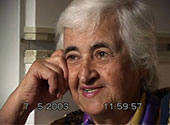
Sonia Litvak was born in 1925 in Novohrad-Volynskyy. She had four siblings. Her father, a leatherworker, was also born in Novohrad-Volynskyy. Her mother worked occasionally as a freelance seamstress. Sonia studied at a Yiddish school. After the war, she worked as a curricular administrator in kindergartens, as well as in a textile factory. In the 1960s, she worked in the cultural department of the Soviet consulate in Germany.
Other Interviews:
The Head of the FishThe Fur Coat
Rivne, Ukraine
In the early years of the Soviet Union, the Jewish Sections of the Communist Party published so called Red Hagaddahs that tried to retell the Passover story as a story of the liberation of the proletariat from the oppression of the bourgeoisie. These Red Hagaddahs were widely distributed through Communist Party youth organizations. Almost none of the people we interviewed remembered the Red Hagaddahs. Instead, they recall traditional seders with their families, but often have difficulty recalling specific details of the ceremony.; Sonia (Sure) Litvak was born in Zvil (Novohrad-Volynskyi), Ukraine in 1925. AHEYM interviewed her in Rivne, Ukraine, in 2003. Sonia was discussing the extreme poverty during the Great Famine (Holodomor) in Ukraine, 1932-1933. She explained that despite the terrible conditions, no one in her family died from the hunger, because her grandmother had managed to save some money for the family.
Sonia's grandmother was a ""bube,"" a kind of midwife and folk healer in Zvil. It is interesting to note that this profession was sufficiently lucrative for her to be able to save up a significant amount of money, enough to sustain the family in years to come. The story Sonia tells in the clip took place in 1918, during the Russian Civil War. Sonia's grandmother had hidden her savings in a fur coat. A ""Denikinovets,"" a soldier from the army of Anton Denikin, entered the house and tried to take the coat. When the grandmother resisted, she was beaten, and she died two days later.
General Denikin was commander of the Volunteer Army, one of the many factions fighting for control of Ukraine during the Civil War that broke out in the wake of the Bolshevik Revolution. The Volunteer Army, commonly known as the Whites, was made up mostly of conservative officers from the tsarist army. They opposed the Red Army's efforts to extend the Revolution and fought for the maintenance of the rights of property owners and priests. During the battles, attacks on the Jews, among other minorities, were quite common. One survey counted 688 cities, towns and villages affected by pogroms. Many of these locales suffered multiple pogroms, as armies and brigands came and went. The pogroms were attributed most often to Ukrainian nationalists, though the White Volunteer Army is said to have been responsible for about twenty percent of the attacks, with Sonia's grandmother being one example of the latter. Because of the grandmother's bravery, Sonia's family kept the hidden money and used it to survive the Famine.
